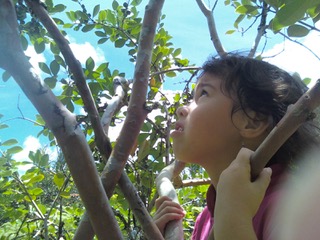August 16, 2020
I felt my lungs inflate with the onrush of scenery—air, mountains, trees, people. I thought, ‘This is what it is to be happy.’ – Sylvia Plath

One morning while sitting in my new “city backyard”, I thought about a phrase from Sylvia in the LifeWays Re-Thinking Care and Education course. She envisioned providing the children in her care with “a taste of wilderness in the suburban backyard.” Much like a suburban habitation, the smaller size of city backyards can give little space or opportunity for luscious outdoor experiences. Yet, as I watched the birds flock about the feeder, then shifted my gaze to the garden boxes and the small arbor that extends to the side yard full of perennials, I was reminded that it does not take much space to create an outdoor environment that is both a nourishing and uplifting retreat.
With a consistent amount of free time and a few choice materials, a world of creation and discovery awaits children of many ages in their backyards. As Sylvia put it, the experience is “an antidote, almost, for their life of distance learning, media and gadgets.” In nature, time slows down and remedies the pace of present day life. Studying the effects of nature on our physiology has become so popular it has even become a scientific field of its own — ecotherapy. Scientists now know that just being in nature reduces blood pressure and decreases stress hormones, such as cortisol, that wreak havoc on multiple systems of the body when high levels are maintained. A long walk in the woods also quiets the prefrontal cortex, the part of the brain that is active when we tend to run the circles of negative thoughts. But beyond physiology, we learn from personal experience that with regular time spent in nature, we connect with ourselves and each other more easily on a spiritual level. We feel our worries and tension drift away and a sense of peace takes their place.
Having been so recently incarnated on this earthly plane, our children especially find deep pleasure in the quietude of our backyards, parks, and nature preserves. I have seen how easily our young children can slip into communion with the natural world, moving beyond space and time, to a place, perhaps, that is more love than anything we can give to them ourselves.
I recall a moment that I glimpsed this in pureness. During my first summer at Rose Rock, I was helping to walk a small group of children across a park to play underneath some trees. I held the hand of a little girl, just two and a half years old, with big eyes, curly light brown hair and a slight figure. She was big-headed and dreamy, full of lightness and laughter. And she simply couldn’t make it across with just a walk! She was so captivated by the sunshine and wide-open sky that she would bounce-step and drop to the ground, rolling around in sheer delight. It didn’t matter what I could have said or done, she was in perfect love with the world around her.
That is what our children need at this moment. That is what we need, too. So, how do we fold into our rhythm time to be outdoors? What activities do we do indoors now that can be re-imagined outdoors? What treasures can we hide in our backyards to entice our children and ourselves into them each day? Let’s explore together in the next few weeks what can bring us all outdoors more.
